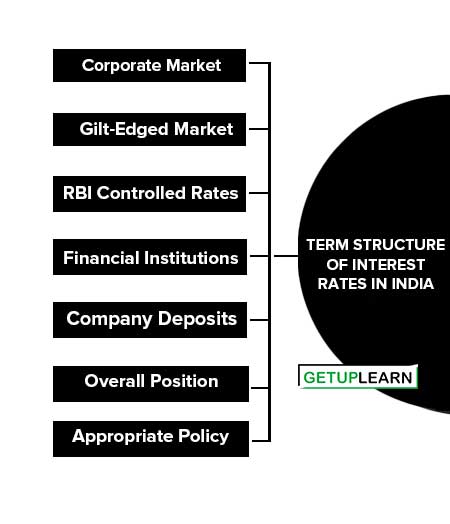Other things being the same, rates of interest also differ according to the term to maturity of the debt. The resulting is called the term structure of interest rates and the curve showing the relationship between yield and term to maturity is called the yield curve.
Low short-term interest rates and high long-term rates indicate an upward-sloping yield curve and, on the contrary, high short-term rates of interest rates and low long-term rates show a downward-sloping yield curve.
Table of Contents
Term Structure of Interest Rates in India
The term structure of interest rates in different spheres of India is briefly discussed below:
- Corporate Market
- Gilt-Edged Market
- RBI Controlled Rates
- Financial Institutions
- Company Deposits
- Overall Position
- Appropriate Policy

Corporate Market
The corporate market is considered a heterogeneous market for the term structure analysis. As a result, the observed differences in rates of interest on different maturity debts cannot be attributed to differences in terms of maturity alone. Additionally, in India, the market for this kind of debt is not well-developed; it is both narrow and shallow.
- Institutional investors generally do not trade in securities.
- Private dealers are small and unimportant. As a result of all these factors, the full significance of differences in terms of maturity for market-determined interest-rate differences cannot be easily assessed and analyzed in the corporate sector in India.
Gilt-Edged Market
Much theoretical and empirical work has been done on the term structure of interest rates in the USA. But this work is of little relevance in the Indian situation. The reason for this is that in the Indian gilt-edged market, the treasury-bill rate and administrated rate, and other rates of Interest are controlled by the RBI.
As far as the yields on government securities are concerned, the demand for long-term securities has increased. The reasons for this are as follows:
- Because of the ready and continuous support to the market by the authorities, the institutions have recognized that long-term securities are as liquid as short-term securities.
- There has been an increase in the resources of investors like LIC, provident funds, etc., which are the major buyers of long-term securities. Finding the ready market for long-term securities, the authorities have been issuing these securities at relatively low coupon rates in order to minimize the cost of public debt.
RBI Controlled Rates
In the case of RBI-controlled rates of interest, the yield curve is upward-sloping:
- For treasury bills, the short-term rate is pegged lower than the long-term rate.
- There is a much greater spread allowed on deposits of banks of different periods; the rates of interest on 15 to 45 days deposits are much lower than the rates on fixed deposits of more than 5 years.
Financial Institutions
The administered lending rates of financial institutions on loans and advances show a reverse term structure; that is, the rates of interest on term loans by development banks are generally lower than the rates of interest charged by commercial banks on their short-term commercial credit.
This policy has been adopted to encourage fixed-asset formation and to discourage inventory holding of goods.
Company Deposits
The rates of interest offered on company deposits also have a rising structure as one moves from one-year deposits to 3-year deposits. Thus, in most cases, the rates of interest are higher on debts (i.e, assets) of long-term maturity. The main reason for this is to encourage long-term public savings or to attract long-term funds.
Overall Position
As far as homogeneous classes of assets are concerned, the long-term interest rates were mostly higher than short-term interest rates till about 1972-73.
Thereafter, either certain short-term rates have tended to exceed some long-term rates, or the spread between these two types has declined. There is no single explanation for this phenomenon. Different forces have been at work in different spheres.
Appropriate Policy
The policy of keeping the long-term interest rates low to encourage fixed investment, and raising the short-term rates of interest to discourage inventory investment should be abandoned.
On the other hand, this does not suggest that short-term interest rates should be reduced in order to establish a proper alignment between the two rates. The proper policy is to allow these rates to find their own levels under free market conditions.
